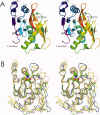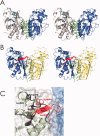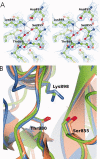Structure of the catalytic domain of the human mitochondrial Lon protease: proposed relation of oligomer formation and activity
- PMID: 20222013
- PMCID: PMC2868241
- DOI: 10.1002/pro.376
Structure of the catalytic domain of the human mitochondrial Lon protease: proposed relation of oligomer formation and activity
Abstract
ATP-dependent proteases are crucial for cellular homeostasis. By degrading short-lived regulatory proteins, they play an important role in the control of many cellular pathways and, through the degradation of abnormally misfolded proteins, protect the cell from a buildup of aggregates. Disruption or disregulation of mammalian mitochondrial Lon protease leads to severe changes in the cell, linked with carcinogenesis, apoptosis, and necrosis. Here we present the structure of the proteolytic domain of human mitochondrial Lon at 2 A resolution. The fold resembles those of the three previously determined Lon proteolytic domains from Escherichia coli, Methanococcus jannaschii, and Archaeoglobus fulgidus. There are six protomers in the asymmetric unit, four arranged as two dimers. The intersubunit interactions within the two dimers are similar to those between adjacent subunits of the hexameric ring of E. coli Lon, suggesting that the human Lon proteolytic domain also forms hexamers. The active site contains a 3(10) helix attached to the N-terminal end of alpha-helix 2, which leads to the insertion of Asp852 into the active site, as seen in M. jannaschii. Structural considerations make it likely that this conformation is proteolytically inactive. When comparing the intersubunit interactions of human with those of E. coli Lon taken with biochemical data leads us to propose a mechanism relating the formation of Lon oligomers with a conformational shift in the active site region coupled to a movement of a loop in the oligomer interface, converting the proteolytically inactive form seen here to the active one in the E. coli hexamer.
Figures




References
-
- Ostersetzer O, Kato Y, Adam Z, Sakamoto W. Multiple intracellular locations of Lon protease in Arabidopsis: evidence for the localization of AtLon4 to chloroplasts. Plant Cell Physiol. 2007;48:881–885. - PubMed
-
- Kikuchi M, Hatano N, Yokota S, Shimozawa N, Imanaka T, Taniguchi H. Proteomic analysis of rat liver peroxisome: presence of peroxisome-specific isozyme of Lon protease. J Biol Chem. 2004;279:421–428. - PubMed
Publication types
MeSH terms
Substances
LinkOut - more resources
Full Text Sources
Molecular Biology Databases

